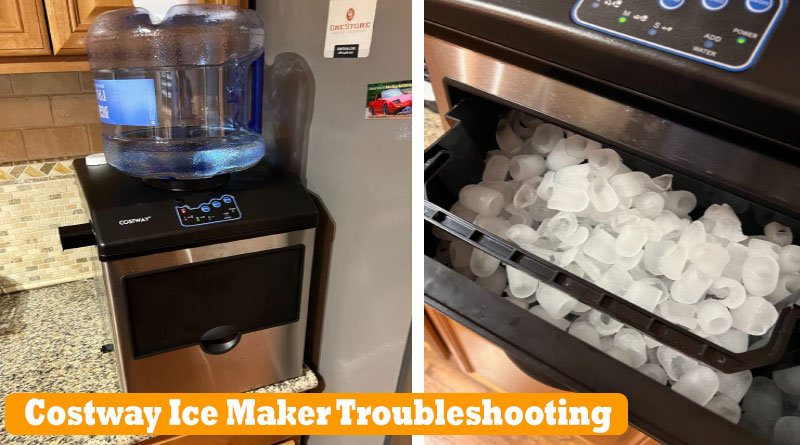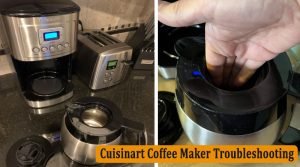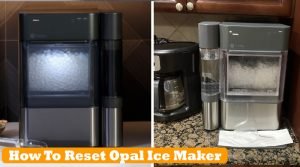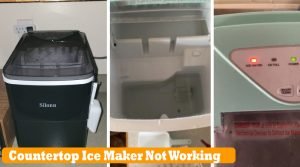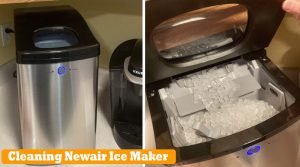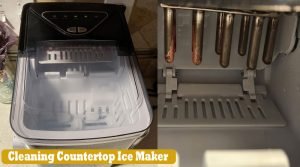Costway Ice Maker Troubleshooting: Revolutionize Ice Experience
The art of Costway ice maker troubleshooting comes into play, offering a pathway to understanding and addressing the common issues that may disrupt the smooth flow of ice production. From irregular ice formation to dispenser malfunctions, navigating through the intricacies of troubleshooting ensures that ice maker continues to be a steadfast contributor to the refreshing moments in daily life.
The ice maker is a stalwart companion in modern conveniences, providing us with the luxury of effortlessly chilled beverages. Yet, even the most reliable ice makers can encounter hiccups.
Home ice makers may seem like straightforward appliances, but they can surprise us with complex issues ranging from a minor inconvenience to a full-blown operation.
We’ll dive into the most common problems you might encounter and the steps you can take to tackle them head-on.
Costway Ice Maker Troubleshooting : Issue and Performance Tips
An automatic ice maker is a marvel when it’s working but a mystery when it’s not—especially if you’re not too familiar with the mechanics. Don’t let the complexity of the machine intimidate you. By knowing a few common troubleshooting tips, you might avoid a costly visit from the repairer or an unnecessary replacement if the issue is a simple fix. We’ve outlined typical problems you might encounter with Costway ice maker and the steps to correct them.
1. No Ice Production
Check Power Supply: Start with the basics. Ensure ice maker is plugged in and the outlet receives power. If ice maker has a switch or a shut-off lever, confirm it’s in the ‘on’ position.
Verify Water Supply: The ice maker can’t make ice without water, so check your unit’s water supply. If water can’t reach the ice maker, replace the water inlet valve, which controls the water flow.
Inspect the Water Inlet Valve: The water inlet valve is a critical component that lets water into the ice maker. If it’s defective, water won’t flow into the ice-making mechanism. Testing and replacing this valve may be necessary.
2. Slow Ice Production
Adjust Temperature Settings: The ideal temperature for ice production is around 0 degrees Fahrenheit. Warmer temperatures can significantly slow down ice-making. Adjust the freezer or ice maker temperature according to your model’s recommendations.
Clean Condenser Coils: Dirty condenser coils can lead to inefficient cooling, which in turn slows down ice production. Regularly cleaning these coils is an essential step in maintaining the efficiency of your ice maker.
Check for Air Leaks: Air leaks in the freezer can let warm air seep in, raising the temperature and slowing ice production. Inspect the freezer door gasket and ensure its properly sealed. Replacing the gasket may be necessary if it’s damaged or worn.
3. Ice Maker Leaking
Examine Water Lines and Connections: Loose or cracked water lines can cause leaks. Check all the water lines for any signs of damage. Tighten connections and replace damaged water lines as needed.
Inspect the Water Inlet Valve: A damaged water inlet valve can lead to overfilling and water leakage. If the valve is faulty, it must be replaced to prevent further leaks and operational issues.
Check Ice Mold and Ice Maker Assembly: Sometimes, the cause of the leak can be less obvious, such as a crack in the ice mold or a misaligned ice maker assembly. Carefully examine these components for damage and ensure they are correctly fitted and installed.
4. Ice Maker Not Dispensing Ice
Clear Blockages in the Ice Bin and Chute: Occasionally, a piece of ice can get lodged in the dispenser, preventing the rest from dispensing. Remove any obstructions, and always ensure the ice bin is seated correctly.
Check the Dispenser Motor and Auger: A malfunctioning motor or auger can prevent ice from dispensing. Test the motor for power and the auger for any mechanical issues that impede its rotation. If either is defective, they will likely need to be replaced.
5. Ice Maker Producing Misshapen Ice
When ice is too small or comes out in odd shapes, it’s not just a matter of aesthetics; it indicates a problem with forming.
Adjust Ice Size Settings: Most ice makers have an adjustment feature for ice cube size. Verify that it’s set to produce ice at the size you prefer.
Clean Ice Mold or Tray: Mineral buildup can cause the ice to stick to the mold or tray. Turn off the ice maker, disconnect the power, and gently clean the parts with a nonabrasive brush.
Check Water Pressure: Inadequate water pressure can lead to small ice cubes. Ensure the water line is fully open and not obstructed.
6. Ice Maker Freezing Up
If you notice a decrease in ice production and a buildup of ice in areas of the machine that are not designed to have ice, you may be dealing with a freezing problem.
Check Temperature Settings: Low temperatures sometimes cause the water to freeze in areas it shouldn’t. Try setting the temperature slightly warmer and see if that helps.
Clean or Replace Water Inlet Valve: If the inlet valve is not opening or closing correctly, it can cause water to freeze in unwanted areas. Clean the valve; if it’s still not working, consider replacing it.
Inspect Water Supply Line for Blockages: Like the advice for the leaking issue, check the water supply line for any kinks or blockages.
7. Ice Maker Noisy Operation
Ice makers can be a bit noisy, but it’s worth investigating if you start hearing loud or irregular sounds.
Level the Ice Maker: If the ice maker isn’t level, the water may not flow correctly, which can cause loud noises. Use a level to ensure its appropriately balanced.
Check for Loose or Worn Parts: Parts can become loose or wear down over time. Tighten any screws or bolts, and if a part looks worn or damaged, it may need to be replaced.
Clean Condenser Coils: Dust and debris can cause the ice maker to work harder, resulting in a noisier operation. Unplug the ice maker and clean the condenser coils with a soft brush.
An automatic ice maker is a marvel when it’s working but a mystery when it’s not—especially if you’re not too familiar with the mechanics. Don’t let the complexity of the machine intimidate you. By knowing a few common troubleshooting tips, you might avoid a costly visit from the repairer or an unnecessary replacement if the issue is a simple fix. Below, we’ve outlined typical problems you might encounter with Costway ice maker and the steps to correct them.
Many common issues can often be resolved by Resetting Opal ice maker
Maintenance and Preventive Tips
Preventative maintenance can help you avoid many issues that hamper ice maker’s efficiency. Here are some tips to keep your ice maker running smoothly
Regular Cleaning and Descaling
Dirt, minerals, and even mold can build up in the ice maker over time, reducing ice production and contamination. Clean the ice maker’s interior, ice bin, and water lines regularly with a mild detergent. descaling ice maker helps to remove mineral deposits, ensuring optimal water flow and ice clarity.
Properly Storing and Using Ice Maker
Using ice maker correctly can significantly prolong its lifespan. Never overload the ice bin, as this can strain the ice maker motor and auger excessively. When you know you won’t be using ice for a while, switch the machine off to save energy and reduce wear on the internal components.
Final Verdict
Costway ice maker, troubleshooting can often be straightforward, involving simple checks and adjustments. By following the troubleshooting steps outlined in this guide, you’ll be able to identify and resolve common issues quickly, keeping the ice flowing as it should.
Remember, regular maintenance is critical to preventing problems and ensuring your ice maker is ready to deliver the cool, refreshing ice you can count on whenever needed.
By familiarizing yourself with ice maker’s components and how they function, and by giving your ice maker the care it deserves, you’ll save time and money on repairs and maximize the lifespan of this home essential. Embrace the DIY spirit when it comes to your ice maker – with some knowledge and some elbow grease, a working ice maker is well reach.
FAQs of Costway Ice Maker Troubleshooting
Q: Why is my Costway ice maker not making ice?
A: There could be several reasons your Costway ice maker is not making ice. It could be due to a lack of water supply, a clogged filter, or the machine in standby mode. Ensure the machine is connected to a water source, the filter is clean, and the machine is set to the correct mode.
Q: My ice maker is making a loud noise. What should I do?
A: Loud noises from ice maker could indicate a problem with the motor or the fan. If you’re uncomfortable checking these parts yourself, calling a professional for help is best.
Q: Why is my ice maker producing small or thin ice cubes?
A: This could be due to low water flow or a high freezer temperature. If the water supply is sufficient and the freezer temperature is set too high, adjust it to a lower setting.
Q: Why is my ice maker leaking water?
A: A leak could be caused by a loose water connection, a cracked reservoir, or a blocked drain line. Check all these parts and repair or replace them as necessary.
Q: The ice tastes terrible. What could be the problem?
A: Bad-tasting ice could be due to stale water or a dirty bucket. Empty the ice bucket regularly and clean it thoroughly. Also, make sure to change the water in the reservoir regularly.
Q: What should I do if my ice maker won’t turn on?
A: First, check if the ice maker is plugged in and the outlet works. If that’s not the problem, it could be an issue with the power cord or the control board, in which case you’ll need to call a professional.

